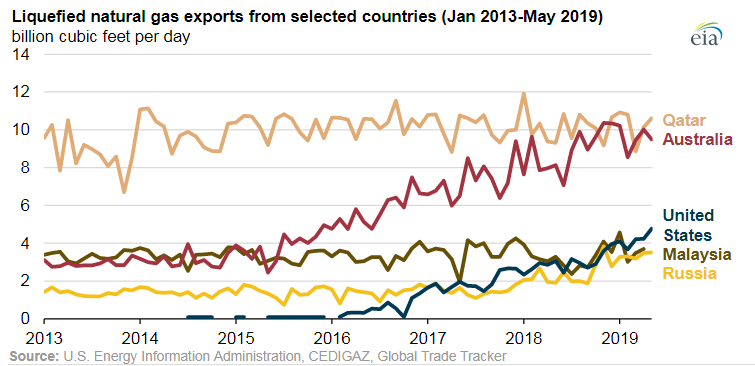By Tim Daiss | January 21, 2020

Qatar, the leading liquified natural gas (LNG) producer for decades, until being eclipsed this year by Australia, is going solar. The tiny gas rich kingdom, however, won’t stay in second place for long. It has plans to ramp up its current 77 million tons per annum (mtpa) of LNG liquefaction capacity to a record-breaking, market changing 126 mtpa by 2027, leaving Australia in its wake.
Qatar’s ramp up in production also likely has geopolitical motivations as well as commercial and market considerations. Looking forward, if there is regime change in neighboring Iran, which shares the gas prolific north field in the Persian Gulf with Qatar, Iran could become a major gas competitor in the region and further abroad as it develops its own LNG infrastructure. Qatar’s LNG maximization plan is also likely a pushback against the boycott put in place by Saudi Arabia, the United Arab Emirates, and Bahrain in 2017 over allegations that Qatar funds and aids radical terror networks – a claim that Doha vehemently denies.
Qatar’s energy minister Saad al-Kaabi said on Sunday that the kingdom had signed an agreement with French oil and gas major Total SA and Japan’s Marubeni to build a $467 million solar power project with capacity of about 800 megawatts (MW).
Kaabi said by the first quarter of 2021, half of the plant’s capacity should be up and running, adding that the project will reach full capacity by the first quarter of 2022.
He said that Qatar plans more solar projects as the country aims to reduce carbon emissions and minimize its impact on the environment. Kaabi said late last year that Qatar had commissioned a carbon capture and storage plant and aims to sequester 5 million tons of carbon from its LNG operations by 2025.
Qatar’s decision to build a solar power plant speaks volumes for how the world’s energy patch is changing as governments, pressure from investors, the general populace and now big oil comes to terms with GHG emissions, to tackle climate change. Although, much of the climate change agenda seems based on sketchy science and is unfortunately pegged to a leftist political agenda.
Big Oil and the power sector are also bowing to pressure to modify its ways and reduce its carbon footprint. Some of this so far has included plans to replace dirty burning coal fired power plants to cleaner burning natural gas plants. However, since gas is still a hydrocarbon, the future of this cleaner burning reliable fuel is now in the cross hairs of the climate change agenda.
These are some of the themes that will be discussed this week at the World Economic Forum in Davos, with a wide range of heads of state attending, including President Trump and German Chancellor Angela Merkel – whose meeting itself will give plenty of opportunity for the leftist media to spin things to their own liking, with Trump likely being presented as the 900-pound gorilla in the room against more dignified and worthy leftist heads of state.
Nonetheless, the Forum’s official theme this year is “Stakeholders for a Cohesive and Sustainable World” and there are more than 30 sessions on the program that grapple with some aspect of climate change, ranging from discussions of youth activism to climate’s impact on public and private health systems, The Wall Street Journal reported yesterday.
Going forward, it would be more productive to divorce climate change concerns from a politically left agenda thus not demonizing those who question the movement’s science but who are still concerned over what’s happening. Yet, if the past is any indication of the future that development will remain a pipe dream.
- The Left Supporting Iran Also Supports Tehran’s Ally Moscow, And Is Evidence Of Russia Hoax [1]
- Don’t Look Now But Ruble Strengthening Against USD [2]
This piece originally appeared on CreativeDestructionMedia.com [3] and is used by permission.